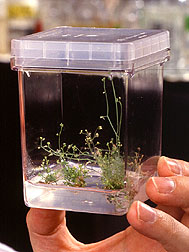This page has been archived and is being provided for reference purposes only. The page is no longer being updated, and therefore, links on the page may be invalid.
Genome Coup Opens Door to New DiscoveriesBy Marcia WoodDecember 13, 2000 WASHINGTON, Dec. 13--Now that the history-making venture to decipher the structure of nearly all the genes in a little mustard family plant called thale cress or mouse ear cress is complete, plant researchers are intent on finding out what job each of those 25,000 genes performs. “This remarkable accomplishment," said U.S. Agriculture Secretary Dan Glickman, “may pave the way for increasing agricultural productivity by improving crop yields and quality to help maintain a global food supply while protecting the environment.”Among the investigators who are pursuing that ambitious goal is Athanasios Theologis, a senior scientist with USDA’s Agricultural Research Service in Albany, Calif., and adjunct professor at the University of California, Berkeley. Theologis co-authored one of several research papers in the December 14 issue of the journal Nature that document his team's success--and that of co-investigators--in elucidating the structure, or "sequence," of all of the genes in the diminutive plant known to botanists as Arabidopsis thaliana. Researchers finished the project three years ahead of schedule. Theologis is based at the Plant Gene Expression Center, which is jointly operated by ARS and the University of California. The Arabidopsis sequencing work is considered to be the first complete, publicly available catalog of the structure of all of the genes that come into play during the life of a flowering plant--from seed to flower to fruit. Scientists hope to discover the traits that these genes control, such as resistance to attack by insects or diseases. Once those genes are identified, scientists may be able to shuttle them into plants that lack natural protection, or they may be able to retool the genes to enhance their effectiveness. Arabidopsis has been the guinea pig for these gene-sequence investigations because it has a much smaller amount of genetic material than familiar crop plants such as corn or wheat. Knowing the structure and--next--the function of Arabidopsis genes helps reveal clues to the form and function of genes in all flowering plants, as well as genes of other forms of life. Theologis worked with scientists at Stanford University and at the University of Pennsylvania to determine the sequence of the genes of one of the five chromosomes in Arabidopsis. Other investigators in the United States, Europe, and Japan sequenced the four other Arabidopsis chromosomes. USDA’s Cooperative State Research, Education and Extension Service helped fund the work. Scientific contacts: Athanasios Theologis, ARS and University of California at Berkeley Plant Gene Expression Center, Albany, Calif., phone (510) 559-5911, fax (510) 559-5678, theo@nature.berkeley.edu or Leland C. Ellis, Jr., ARS National Program Staff, Beltsville, Md., phone (301) 504-4788, fax (301) 504- 4725, lce@ars.usda.gov. |

